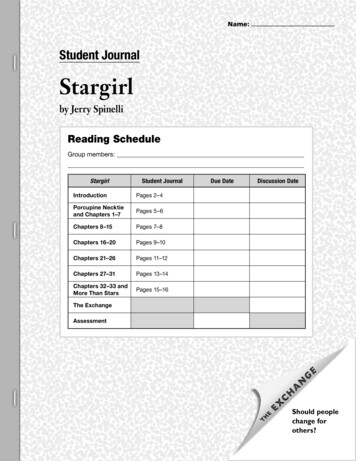
Transcription
Introduction to Razor Pages in ASP.NET core/razor-pages/?view aspnetcore-3.1&tabs visual-studioRazor Pages can make coding page-focused scenarios easier and more productive than usingcontrollers and views.If you're looking for a tutorial that uses the Model-View-Controller approach, see Get startedwith ASP.NET Core MVC.This document provides an introduction to Razor Pages. It's not a step by step tutorial.If you find some of the sections too advanced, see Get started with Razor Pages /tutorials/razor-pages/razor-pages-start?view aspnetcore3.1&tabs visual-studio).For an overview of ASP.NET Core, see the Introduction to ASP.NET Core.Prerequisites Visual StudioVisual Studio CodeVisual Studio for Mac Visual Studio 2019 with the ASP.NET and web development workload .NET Core 3.0 SDK or laterCreate a Razor Pages projectSee Get started with Razor Pages for detailed instructions on how to create a Razor Pagesproject.Razor PagesRazor Pages is enabled in Startup.cs:public class Startup{public Startup(IConfiguration configuration){Configuration configuration;}
public IConfiguration Configuration { get; }public void ConfigureServices(IServiceCollection services){services.AddRazorPages();}public void Configure(IApplicationBuilder app, IWebHostEnvironment env){if UseEndpoints(endpoints {endpoints.MapRazorPages();});}}Consider a basic page:@page h1 Hello, world! /h1 h2 The time on the server is @DateTime.Now /h2 The preceding code looks a lot like a Razor view file used in an ASP.NET Core app withcontrollers and views. What makes it different is the @page directive. @page makes the file intoan MVC action - which means that it handles requests directly, without going through acontroller. @page must be the first Razor directive on a page. @page affects the behavior ofother Razor constructs. Razor Pages file names have a .cshtml suffix.
A similar page, using a PageModel class, is shown in the following two files.The Pages/Index2.cshtml file:@page@using RazorPagesIntro.Pages@model Index2Model !-- Namespace for Index2Model class -- h2 Separate page model /h2 p @Model.Message /p The Pages/Index2.cshtml.cs page model:using Microsoft.AspNetCore.Mvc.RazorPages;using Microsoft.Extensions.Logging;using System;namespace RazorPagesIntro.Pages{public class Index2Model : PageModel{public string Message { get; private set; } "PageModel in C#";public void OnGet(){Message " Server time is { DateTime.Now }";}}}By convention, the PageModel class file has the same name as the Razor Page filewith .cs appended. For example, the previous Razor Page is Pages/Index2.cshtml. The filecontaining the PageModel class is named Pages/Index2.cshtml.cs.The associations of URL paths to pages are determined by the page's location in the filesystem. The following table shows a Razor Page path and the matching URL:TABLE 1File name and pathmatching Store/Index.cshtml/Storeor /Indexor /Store/Index
Notes:The runtime looks for Razor Pages files in the Pages folder by default.Index is the default page when a URL doesn't include a page. Write a basic formRazor Pages is designed to make common patterns used with web browsers easy to implementwhen building an app. Model binding, Tag Helpers, and HTML helpers all just work with theproperties defined in a Razor Page class. Consider a page that implements a basic "contact us"form for the Contact model:For the samples in this document, the DbContext is initialized in the Startup.cs file.public void ConfigureServices(IServiceCollection services){services.AddDbContext CustomerDbContext (options azorPages();}The data model:using System.ComponentModel.DataAnnotations;namespace RazorPagesContacts.Models{public class Customer{public int Id { get; set; }[Required, StringLength(10)]public string Name { get; set; }}}The db context:using Microsoft.EntityFrameworkCore;using RazorPagesContacts.Models;namespace RazorPagesContacts.Data{public class CustomerDbContext : DbContext
{public CustomerDbContext(DbContextOptions options): base(options){}public DbSet Customer Customers { get; set; }}}The Pages/Create.cshtml view file:@page@model TagHelper *, Microsoft.AspNetCore.Mvc.TagHelpers p Enter a customer name: /p form method "post" Name: input asp-for "Customer.Name" / input type "submit" / /form The Pages/Create.cshtml.cs page hreading.Tasks;namespace RazorPagesContacts.Pages.Customers{public class CreateModel : PageModel{private readonly CustomerDbContext context;public CreateModel(CustomerDbContext context){context context;}public IActionResult OnGet(){return Page();}
[BindProperty]public Customer Customer { get; set; }public async Task IActionResult OnPostAsync(){if (!ModelState.IsValid){return Page();}context.Customers.Add(Customer);await context.SaveChangesAsync();return RedirectToPage("./Index");}}}By convention, the PageModel class is called PageName Model and is in the same namespace asthe page.The PageModel class allows separation of the logic of a page from its presentation. It definespage handlers for requests sent to the page and the data used to render the page. Thisseparation allows: Managing of page dependencies through dependency injection.Unit testingThe page has an OnPostAsync handler method, which runs on POST requests (when a user poststhe form). Handler methods for any HTTP verb can be added. The most common handlers are: to initialize state needed for the page. In the preceding code, the OnGet methoddisplays the CreateModel.cshtml Razor Page.OnPost to handle form submissions.OnGetThe Async naming suffix is optional but is often used by convention for asynchronous functions.The preceding code is typical for Razor Pages.If you're familiar with ASP.NET apps using controllers and views: The OnPostAsync code in the preceding example looks similar to typical controller code.Most of the MVC primitives like model binding, validation, and action results work thesame with Controllers and Razor Pages.
The previous OnPostAsync method:public async Task IActionResult OnPostAsync(){if (!ModelState.IsValid){return Page();}context.Customers.Add(Customer);await context.SaveChangesAsync();return RedirectToPage("./Index");}The basic flow of OnPostAsync:Check for validation errors. If there are no errors, save the data and redirect.If there are errors, show the page again with validation messages. In many cases,validation errors would be detected on the client, and never submitted to the server.The Pages/Create.cshtml view file:@page@model TagHelper *, Microsoft.AspNetCore.Mvc.TagHelpers p Enter a customer name: /p form method "post" Name: input asp-for "Customer.Name" / input type "submit" / /form The rendered HTML from Pages/Create.cshtml: p Enter a customer name: /p form method "post" Name: input type "text" data-val "true"data-val-length "The field Name must be a string with a maximum length of 10."data-val-length-max "10" data-val-required "The Name field is required."
id "Customer Name" maxlength "10" name "Customer.Name" value "" / input type "submit" / input name " RequestVerificationToken" type "hidden"value " Antiforgery token here " / /form In the previous code, posting the form:With valid data:o The OnPostAsync handler method calls the RedirectToPage helpermethod. RedirectToPage returns an instance of RedirectToPageResult. RedirectToPage: Is an action result. Is similar to RedirectToAction or RedirectToRoute (used in controllers and views). Is customized for pages. In the preceding sample, it redirects to the root Index page(/Index). RedirectToPage is detailed in the URL generation for Pages section. With validation errors that are passed to the server:o The OnPostAsync handler method calls the Page helper method. Page returns an instanceof PageResult. Returning Page is similar to how actions in controllersreturn View. PageResult is the default return type for a handler method. A handlermethod that returns void renders the page.o In the preceding example, posting the form with no value resultsin ModelState.IsValid returning false. In this sample, no validation errors are displayedon the client. Validation error handing is covered later in this document. public async Task IActionResult OnPostAsync(){if (!ModelState.IsValid){return Page();}context.Customers.Add(Customer);await context.SaveChangesAsync();return RedirectToPage("./Index");} With validation errors detected by client side validation:o Data is not posted to the server.o Client-side validation is explained later in this document.The Customer property uses [BindProperty] attribute to opt in to model binding:public class CreateModel : PageModel{
private readonly CustomerDbContext context;public CreateModel(CustomerDbContext context){context context;}public IActionResult OnGet(){return Page();}[BindProperty]public Customer Customer { get; set; }public async Task IActionResult OnPostAsync(){if (!ModelState.IsValid){return Page();}context.Customers.Add(Customer);await context.SaveChangesAsync();return RedirectToPage("./Index");}}should not be used on models containing properties that should not bechanged by the client. For more information, see Overposting.[BindProperty]Razor Pages, by default, bind properties only with non-GET verbs. Binding to propertiesremoves the need to writing code to convert HTTP data to the model type. Binding reducescode by using the same property to render form fields ( input asp-for "Customer.Name" ) andaccept the input.WarningFor security reasons, you must opt in to binding GET request data to page model properties.Verify user input before mapping it to properties. Opting into GET binding is useful whenaddressing scenarios that rely on query string or route values.To bind a property on GET requests, set the [BindProperty] attribute's SupportsGet propertyto true:
[BindProperty(SupportsGet true)]For more information, see ASP.NET Core Community Standup: Bind on GET discussion(YouTube).Reviewing the Pages/Create.cshtml view file:@page@model TagHelper *, Microsoft.AspNetCore.Mvc.TagHelpers p Enter a customer name: /p form method "post" Name: input asp-for "Customer.Name" / input type "submit" / /form In the preceding code, the input tag helper input asp-for "Customer.Name" / binds theHTML input element to the Customer.Name model expression.@addTagHelper makes Tag Helpers available.The home pageIndex.cshtml is the home page:@page@model agHelper *, Microsoft.AspNetCore.Mvc.TagHelpers h1 Contacts home page /h1 form method "post" table class "table" thead tr th ID /th th Name /th /tr /thead tbody @foreach (var contact in Model.Customer){ tr td @contact.Id /td
td @contact.Name /td td a asp-page "./Edit" asp-route-id "@contact.Id" Edit /a button type "submit" asp-page-handler "delete"asp-route-id "@contact.Id" delete /button /td /tr } /tbody /table a asp-page "Create" Create New /a /form The associated PageModel class (Index.cshtml.cs):public class IndexModel : PageModel{private readonly CustomerDbContext context;public IndexModel(CustomerDbContext context){context context;}public IList Customer Customer { get; set; }public async Task OnGetAsync(){Customer await context.Customers.ToListAsync();}public async Task IActionResult OnPostDeleteAsync(int id){var contact await context.Customers.FindAsync(id);if (contact ! null){context.Customers.Remove(contact);await context.SaveChangesAsync();}return RedirectToPage();}}The Index.cshtml file contains the following markup:
a asp-page "./Edit" asp-route-id "@contact.Id" Edit /a The a /a Anchor Tag Helper used the asp-route-{value} attribute to generate a link to theEdit page. The link contains route data with the contact ID. Forexample, https://localhost:5001/Edit/1. Tag Helpers enable server-side code to participate increating and rendering HTML elements in Razor files.The Index.cshtml file contains markup to create a delete button for each customer contact: button type "submit" asp-page-handler "delete"asp-route-id "@contact.Id" deleteThe rendered HTML: button type "submit" formaction "/Customers?id 1&handler delete" delete /button When the delete button is rendered in HTML, its formaction includes parameters for: The customer contact ID, specified by the asp-route-id attribute.The handler, specified by the asp-page-handler attribute.When the button is selected, a form POST request is sent to the server. By convention, the nameof the handler method is selected based on the value of the handler parameter according tothe scheme OnPost[handler]Async.Because the handler is delete in this example, the OnPostDeleteAsync handler method is used toprocess the POST request. If the asp-page-handler is set to a different value, such as remove, ahandler method with the name OnPostRemoveAsync is selected.public async Task IActionResult OnPostDeleteAsync(int id){var contact await context.Customers.FindAsync(id);if (contact ! null){context.Customers.Remove(contact);await context.SaveChangesAsync();}return RedirectToPage();}The OnPostDeleteAsync method: Gets the id from the query string.
Queries the database for the customer contact with FindAsync.If the customer contact is found, it's removed and the database is updated.Calls RedirectToPage to redirect to the root Index page (/Index).The Edit.cshtml file@page "{id:int}"@model gHelper *, Microsoft.AspNetCore.Mvc.TagHelpers h1 Edit Customer - @Model.Customer.Id /h1 form method "post" div asp-validation-summary "All" /div input asp-for "Customer.Id" type "hidden" / div label asp-for "Customer.Name" /label div input asp-for "Customer.Name" / span asp-validation-for "Customer.Name" /span /div /div div button type "submit" Save /button /div /form The first line contains the @page "{id:int}" directive. The routing constraint"{id:int}" tells thepage to accept requests to the page that contain int route data. If a request to the pagedoesn't contain route data that can be converted to an int, the runtime returns an HTTP 404(not found) error. To make the ID optional, append ? to the route constraint:@page "{id:int?}"The Edit.cshtml.cs file:public class EditModel : PageModel{private readonly CustomerDbContext context;public EditModel(CustomerDbContext context){context context;}
[BindProperty]public Customer Customer { get; set; }public async Task IActionResult OnGetAsync(int id){Customer await context.Customers.FindAsync(id);if (Customer null){return RedirectToPage("./Index");}return Page();}public async Task IActionResult OnPostAsync(){if (!ModelState.IsValid){return Page();}context.Attach(Customer).State EntityState.Modified;try{await context.SaveChangesAsync();}catch (DbUpdateConcurrencyException){throw new Exception( "Customer {Customer.Id} not found!");}return RedirectToPage("./Index");}}ValidationValidation rules: Are declaratively specified in the model class.Are enforced everywhere in the app.
The System.ComponentModel.DataAnnotations namespace provides a set of built-in validationattributes that are applied declaratively to a class or property. DataAnnotations also containsformatting attributes like [DataType] that help with formatting and don't provide anyvalidation.Consider the Customer model:using System.ComponentModel.DataAnnotations;namespace RazorPagesContacts.Models{public class Customer{public int Id { get; set; }[Required, StringLength(10)]public string Name { get; set; }}}Using the following Create.cshtml view file:@page@model TagHelper *, Microsoft.AspNetCore.Mvc.TagHelpers p Validation: customer name: /p form method "post" div asp-validation-summary "ModelOnly" /div span asp-validation-for "Customer.Name" /span Name: input asp-for "Customer.Name" / input type "submit" / /form script src " /lib/jquery/dist/jquery.js" /script script src " /lib/jquery-validation/dist/jquery.validate.js" /script script src " .unobtrusive.js" /script The preceding code:Includes jQuery and jQuery validation scripts. Uses the div / and span / Tag Helpers to enable:o Client-side validation.o Validation error rendering.
Generates the following HTML: p Enter a customer name: /p form method "post" Name: input type "text" data-val "true"data-val-length "The field Name must be a string with a maximum length of 10."data-val-length-max "10" data-val-required "The Name field is required."id "Customer Name" maxlength "10" name "Customer.Name" value "" / input type "submit" / input name " RequestVerificationToken" type "hidden"value " Antiforgery token here " / /form script src "/lib/jquery/dist/jquery.js" /script script src "/lib/jquery-validation/dist/jquery.validate.js" /script script src .unobtrusive.js" /script Posting the Create form without a name value displays the error message "The Name field isrequired." on the form. If JavaScript is enabled on the client, the browser displays the errorwithout posting to the server.The [StringLength(10)] attribute generates data-val-length-max "10" on the renderedHTML. data-val-length-max prevents browsers from entering more than the maximum lengthspecified. If a tool such as Fiddler is used to edit and replay the post: With the name longer than 10.The error message "The field Name must be a string with a maximum length of 10." isreturned.Consider the following Movie model:public class Movie{public int ID { get; set; }[StringLength(60, MinimumLength 3)][Required]public string Title { get; set; }[Display(Name "Release Date")]
[DataType(DataType.Date)]public DateTime ReleaseDate { get; set; }[Range(1, 100)][DataType(DataType.Currency)][Column(TypeName "decimal(18, 2)")]public decimal Price { get; set; }[RegularExpression(@" [A-Z] [a-zA-Z""'\s-]* ")][Required][StringLength(30)]public string Genre { get; set; }[RegularExpression(@" [A-Z] [a-zA-Z0-9""'\s-]* ")][StringLength(5)][Required]public string Rating { get; set; }}The validation attributes specify behavior to enforce on the model properties they're appliedto: The Required and MinimumLength attributes indicate that a property must have a value, butnothing prevents a user from entering white space to satisfy this validation.The RegularExpression attribute is used to limit what characters can be input. In thepreceding code, "Genre":o Must only use letters.o The first letter is required to be uppercase. White space, numbers, and specialcharacters are not allowed.The RegularExpression "Rating":o Requires that the first character be an uppercase letter.o Allows special characters and numbers in subsequent spaces. "PG-13" is valid for arating, but fails for a "Genre".The Range attribute constrains a value to within a specified range.The StringLength attribute sets the maximum length of a string property, and optionallyits minimum length.Value types (such as decimal, int, float, DateTime) are inherently required and don't needthe [Required] attribute.The Create page for the Movie model shows displays errors with invalid values:
For more information, see: Add validation to the Movie appModel validation in ASP.NET Core.Handle HEAD requests with an OnGet handler fallbackrequests allow retrieving the headers for a specific resource.Unlike GET requests, HEAD requests don't return a response body.HEADOrdinarily, an OnHead handler is created and called for HEAD requests:public void OnHead(){HttpContext.Response.Headers.Add("Head Test", "Handled by OnHead!");}Razor Pages falls back to calling the OnGet handler if no OnHead handler is defined.XSRF/CSRF and Razor PagesRazor Pages are protected by Antiforgery validation. The FormTagHelper injects antiforgerytokens into HTML form elements.Using Layouts, partials, templates, and Tag Helpers withRazor PagesPages work with all the capabilities of the Razor view engine. Layouts, partials, templates, TagHelpers, ViewStart.cshtml, and ViewImports.cshtml work in the same way they do forconventional Razor views.Let's declutter this page by taking advantage of some of those capabilities.Add a layout page to Pages/Shared/ Layout.cshtml: !DOCTYPE html html head title RP Sample /title link rel "stylesheet" href " /lib/bootstrap/dist/css/bootstrap.css" / /head body
a asp-page "/Index" Home /a a asp-page "/Customers/Create" Create /a a asp-page "/Customers/Index" Customers /a br / @RenderBody() script src " /lib/jquery/dist/jquery.js" /script script src " /lib/jquery-validation/dist/jquery.validate.js" /script script src " unobtrusive.js" /script /body /html The Layout: Controls the layout of each page (unless the page opts out of layout).Imports HTML structures such as JavaScript and stylesheets.The contents of the Razor page are rendered where @RenderBody() is called.For more information, see layout page.The Layout property is set in Pages/ ViewStart.cshtml:@{Layout " Layout";}The layout is in the Pages/Shared folder. Pages look for other views (layouts, templates,partials) hierarchically, starting in the same folder as the current page. A layout inthe Pages/Shared folder can be used from any Razor page under the Pages folder.The layout file should go in the Pages/Shared folder.We recommend you not put the layout file in the Views/Shared folder. Views/Shared is an MVCviews pattern. Razor Pages are meant to rely on folder hierarchy, not path conventions.View search from a Razor Page includes the Pages folder. The layouts, templates, and partialsused with MVC controllers and conventional Razor views just work.Add a Pages/ ViewImports.cshtml file:@namespace RazorPagesContacts.Pages@addTagHelper *, Microsoft.AspNetCore.Mvc.TagHelpersis explained later in the tutorial. The @addTagHelper directive brings in the built-inTag Helpers to all the pages in the Pages folder.@namespace
The @namespace directive set on a page:@page@namespace RazorPagesIntro.Pages.Customers@model NameSpaceModel h2 Name space /h2 p @Model.Message /p The @namespace directive sets the namespace for the page. The @model directive doesn't need toinclude the namespace.When the @namespace directive is contained in ViewImports.cshtml, the specified namespacesupplies the prefix for the generated namespace in the Page that importsthe @namespace directive. The rest of the generated namespace (the suffix portion) is the dotseparated relative path between the folder containing ViewImports.cshtml and the foldercontaining the page.For example, the PageModel class Pages/Customers/Edit.cshtml.cs explicitly sets the namespace:namespace RazorPagesContacts.Pages{public class EditModel : PageModel{private readonly AppDbContext db;public EditModel(AppDbContext db){db db;}// Code removed for brevity.The Pages/ ViewImports.cshtml file sets the following namespace:@namespace RazorPagesContacts.Pages@addTagHelper *, Microsoft.AspNetCore.Mvc.TagHelpersThe generated namespace for the Pages/Customers/Edit.cshtml Razor Page is the same asthe PageModel class.@namespacealso works with conventional Razor views.
Consider the Pages/Create.cshtml view file:@page@model TagHelper *, Microsoft.AspNetCore.Mvc.TagHelpers p Validation: customer name: /p form method "post" div asp-validation-summary "ModelOnly" /div span asp-validation-for "Customer.Name" /span Name: input asp-for "Customer.Name" / input type "submit" / /form script src " /lib/jquery/dist/jquery.js" /script script src " /lib/jquery-validation/dist/jquery.validate.js" /script script src " .unobtrusive.js" /script The updated Pages/Create.cshtml view file with ViewImports.cshtml and the preceding layoutfile:@page@model CreateModel p Enter a customer name: /p form method "post" Name: input asp-for "Customer.Name" / input type "submit" / /form In the preceding code, the ViewImports.cshtml imported the namespace and Tag Helpers. Thelayout file imported the JavaScript files.The Razor Pages starter project contains the Pages/ ValidationScriptsPartial.cshtml, whichhooks up client-side validation.For more information on partial views, see Partial views in ASP.NET Core.
URL generation for PagesThe Create page, shown previously, uses RedirectToPage:public class CreateModel : PageModel{private readonly CustomerDbContext context;public CreateModel(CustomerDbContext context){context context;}public IActionResult OnGet(){return Page();}[BindProperty]public Customer Customer { get; set; }public async Task IActionResult OnPostAsync(){if (!ModelState.IsValid){return Page();}context.Customers.Add(Customer);await context.SaveChangesAsync();return RedirectToPage("./Index");}}The app has the following file/folder structure: /Pageso Index.cshtmlo Privacy.cshtmlo /Customers Create.cshtml Edit.cshtml Index.cshtml
The Pages/Customers/Create.cshtml and Pages/Customers/Edit.cshtml pages redirectto Pages/Customers/Index.cshtml after success. The string ./Index is a relative page name usedto access the preceding page. It is used to generate URLs tothe Pages/Customers/Index.cshtml page. For example: Url.Page("./Index", .) a asp-page "./Index" Customers Index Page /a RedirectToPage("./Index")The absolute page name /Index is used to generate URLs to the Pages/Index.cshtml page. Forexample: Url.Page("/Index", .) a asp-page "/Index" Home Index Page /a RedirectToPage("/Index")The page name is the path to the page from the root /Pages folder including a leading / (forexample, /Index). The preceding URL generation samples offer enhanced options andfunctional capabilities over hard-coding a URL. URL generation uses routing and can generateand encode parameters according to how the route is defined in the destination path.URL generation for pages supports relative names. The following table shows which Index pageis selected using different RedirectToPage parameters in Pages/Customers/Create.cshtml.TABLE Index"), RedirectToPage("./Index") ,and RedirectToPage("./Index") are relativenames. The RedirectToPage parameter is combined with the path of the current page tocompute the name of the destination page.Relative name linking is useful when building sites with a complex structure. When relativenames are used to link between pages in a folder: Renaming a folder doesn't break the relative links.Links are not broken because they don't include the folder name.To redirect to a page in a different Area, specify the area:RedirectToPage("/Index", new { area "Services" });
For more information, see Areas in ASP.NET Core and Razor Pages route and app conventionsin ASP.NET Core.ViewData attributeData can be passed to a page with ViewDataAttribute. Properties with the [ViewData] attributehave their values stored and loaded from the ViewDataDictionary.In the following example, the AboutModel applies the [ViewData] attribute to the Title property:public class AboutModel : PageModel{[ViewData]public string Title { get; } "About";public void OnGet(){}}In the About page, access the Title property as a model property: h1 @Model.Title /h1 In the layout, the title is read from the ViewData dictionary: !DOCTYPE html html lang "en" head title @ViewData["Title"] - WebApplication /title .TempDataASP.NET Core exposes the TempData. This property stores data until it's read.The Keep and Peek methods can be used to examine the data without deletion. TempData isuseful for redirection, when data is needed for more than a single request.The following code sets the value of Message using TempData:public class CreateDotModel : PageModel{private readonly AppDbContext db;
public CreateDotModel(AppDbContext db){db db;}[TempData]public string Message { get; set; }[BindProperty]public Customer Customer { get; set; }public async Task IActionResult OnPostAsync(){if (!ModelState.IsValid){return Page();}db.Customers.Add(Customer);await db.SaveChangesAsync();Message "Customer {Customer.Name} added";return RedirectToPage("./Index");}}The following markup in the Pages/Customers/Index.cshtml file displays the valueof Message using TempData. h3 Msg: @Model.Message /h3 The Pages/Customers/Index.cshtml.cs page model applies the [TempData] attribute tothe Message property.[TempData]public string Message { get; set; }For more information, see TempData.
Multiple handlers per pageThe following page generates markup for two handlers using the asp-page-handler Tag Helper:@page@model CreateFATHModel html body p Enter your name. /p div asp-validation-summary "All" /div form method "POST" div Name: input asp-for "Customer.Name" / /div input type "submit" asp-page-handler "JoinList" value "Join" / input type "submit" asp-page-handler "JoinListUC" value "JOIN UC" / /form /body /html The form in the preceding example has two submit buttons, each usingthe FormActionTagHel
If you're looking for a tutorial that uses the Model-View-Controller approach, see Get started with ASP.NET Core MVC. This document provides an introduction to Razor Pages. It's not a step by step tutorial. If you find some of the sections too advanced, see Get started with Razor Pages (link:










